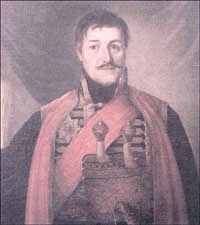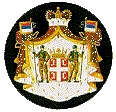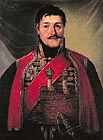Karadjordje
|
DJORDJE PETROVICH - KARADJORDJE Supreme Commander of Serbs 1804-1813 |
|
|
Karadjordje came from a poor family. In the middle of 1787 his family escaped to Srem, in order to evade Turkish retaliation. Karadjordje was first in service at the Krushedol monastery, and at the end of the same year he took part in the unsuccessful Austrian attack on Belgrade. During the Austian-Turkish war he fought in the Western Serbia and got a valuable military experience, which he would use in the First Serbian Uprising. The Uprising was preceded by the bloody Turkish calling to account the most distinguished Serbs, known as the "killing of the village mayors". It took place when governors of Belgrade area run by pasha, found out that Serbs were preparing a conspiracy against them. Killing of the national leaders provoked even greater rancour of the people, their resistance and first serious clashes.
On February 2, 1804 a national assembly was held in Orashac, where the eminent representatives of the people of Shumadiya elected Karadjordje the leader of the Uprising. With the help of Stanoye Glavash, Kaadjordje immediately took steps toward a quick spread of uprising, and connected the local resistance into a single general national movement. Starting from March of the same year, Karadjordje signed all the documents as "the Leader", "First Commander", "Supreme Duke", "Commander of Serbia".
Rejecting
negotiations with the Turkish governors, Karadjordje insisted on their
leaving Belgrade, abolishing feudal relationship and establishing internal
autonomous administration in Belgrade area. Since the Turks did not
agree with such conditions, the fights went on throughout 1805, as well.
At the beginning of the following year the uprising spread out of the Belgrade area. In the middle of the same year the insurgents defeated the Turkish offensive and won an important battle on Mishar mountain (August 13). At the end of 1806 Belgrade was liberated, and Shabac and Uzhice in 1807
Those Serbian victories, as well as the beginning of the Russian-Turkish war at the end of 1806, forced the Turks to negotiate peace. The so-called "Ichko’s Peace" was signed, according to which Serbia was to become a vassal princedom of Turkish Empire, obliged only to pay annual taxes and have in Belgrade one imperial representative.
However, Karadjordje’s ambitions were to liberate all the Serbs under Turkish rule and to acquire full independence. Therefore he entered into new alliance with Russia, and in spring of 1807 continued his war against the Turks. Pressed by Napoleon’s campaign against Russia, the Russian Emperor Alexander I, after many-month’s negotiations signed the peace treaty with the Turks on May 28,1812. According to regulations of the treaty, Serbia only got some self-governing possibilities, while the Turkish army was free to re-occupy the already liberated towns. Neither Serbs nor Turks were satisfied. In 1813 the Turks launched a full-scale offensive and managed to break the resistance of the insurgents on the Morava, the Drina and the Timok rivers. In autumn of the same year Karadjordje and the most eminent Serbian dukes were obliged to flee the country and go to Austria.
In 1816 Karadjordje joined the Greek "Heteria", the aim of which was a joint uprising of Greeks, Serbs and Bulgarians, as well as constitution of a great Balkans state, modelled on the former Byzantine state.
Karadjordje was elected the leader of that uprising. He secretly came to Serbia in July 1817, in order to settle the details of a joint action with Milosh Obrenovich. However, Milosh ordered Karadjordje’s execution, "for state reasons". The execution was carried out in the place named Radovanye, near Smederevo, in the night between July 13 and 14, 1817. |
|


